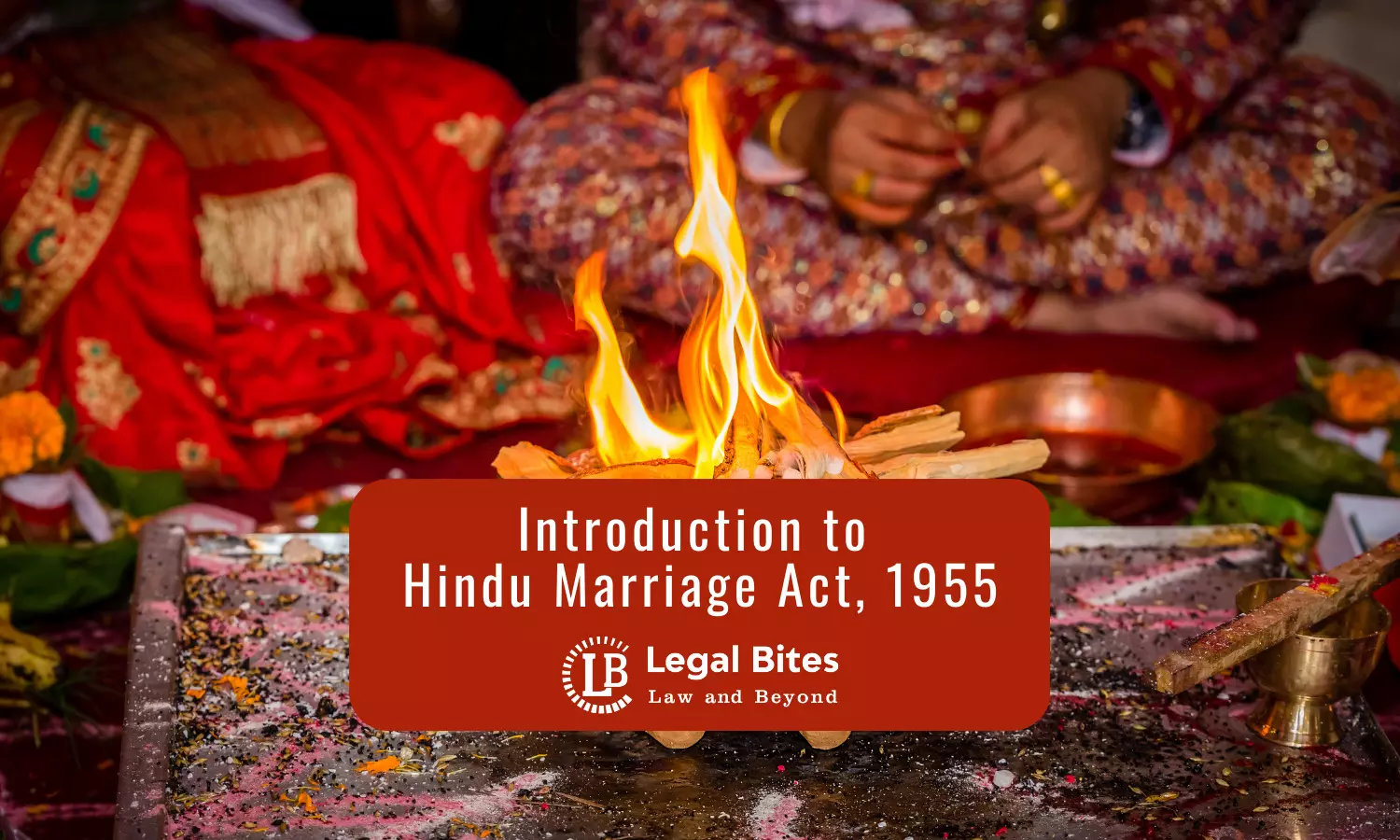Introduction to Hindu Marriage Act, 1955
Marriages in India hold a very special place with regard to every religion’s own norms and practices. Hindu law, in particular, regards marriage as a divine interconnection between two souls for eternity.

Marriages in India hold a very special place with regard to every religion’s own norms and practices. Hindu law, in particular, regards marriage as a divine interconnection between two souls for eternity. This objective can also be read between the lines of the Hindu Marriage Act, 1955 which provides for a basic yet elaborative concept of marriage as per Hindu law. In this article, we shall attempt at understanding marriages from Hindu law’s perspective.
Introduction
Hindus have traditionally viewed marriage as a deeply spiritual and divine rite. Hindu Marriage Act of 1955 prohibited polygamy (having more than one wife), which was a belief held by some Hindus. The HMA Act has also made a number of other modifications to the traditional Hindu marriage rituals. The Hindu culture is widely recognised for its numerous rituals and customs that form part of the whole marriage. Let us comprehend some of the basic tenets of marriage as per Hindu Marriage Act, 1955.
What is Hindu Marriage Act, 1955?
Hindu marriages are governed by an act referred to as the Hindu Marriage Act, 1955. It stipulates conditions that confirm and validate or else invalidate, dissolve, or reconcile married couples. Additionally, it offers details on the courts that legitimately handle cases involving the HMA, 1955.
Concept of Hindu Marriage Act: Sacrament or Contract?
In order to understand this, it is important to know about the case Manmohini v. Basant Kumar, (ILR 28 Cal. 758) where it was held by the Court that Hindu marriages must be regarded as a sacrament instead of a formal contract.
Marriage is not a contract according to the Hindu Marriage Act of 1955, but rather is seen as a sacrament with a solemn commitment. Hindus view marriage as a sacred institution. There was no requirement for the girl's consent during the ancient era, where the fathers had to make decisions without seeking the girl’s opinion or approval. Although not entirely a contract, the relationship between a man and woman is one of faith. Hinduism views marriage as a sacred sacrament since it can only be consummated via ritual and ceremony.
Salient Features of Hindu Marriage Laws
Some of the features are:
i) In the Hindu Marriage Act of 1955, customs and long-standing usages (Reeti-Riwaz) are respected.
ii) Hindus require the practice of saptapadi, or the actions the bride and groom must do before the sacred fire, in order to consummate their union. Marriage ceremonies are nevertheless accepted and governed by customs.
iii) The HMA Act was the only law that introduced divorce to Hindus.
iv) Also, it put an end to the widespread practice of bigamy, polyandry, or other forms of numerous marriages.
v) Hindu marriages must be registered in accordance with the rules that apply in each state. Nonetheless, a lack of a formal document does not render a marriage unlawful or illegal.
vi) Hindu marriage and divorce cases in India are handled according to process.
vii) The HMA Act, unlike any other matrimonial laws in India, also includes a provision for the restoration of conjugal rights (RCR). Hence, if a spouse separates from the other without a good reason, the other spouse may ask the court to end the separation and bring the spouse back.
Conditions for Valid Marriage under HMA Act
The following 7 essentials will give a brief of all the necessary and mandatory conditions for a valid marriage as per Hindu law. The conditions can be understood as elaborated below:
1. Parties to the marriage must be ‘Hindu’
The requirements for a valid Hindu marriage are outlined in Section 5 of the Hindu Marriage Act of 1955, which stipulates that both spouses must be Hindus. According to the Hindu Marriage Act of 1955, a marriage is not regarded as a legitimate Hindu marriage if one of the partners is a Christian or a Muslim. As a result, under the Act of 1955, a valid marriage cannot be conducted if neither party belongs to the Hindu religion.
Yamunabai Anant Rao Adhav v. Anant Rao Shivaram Adhav, (1988 AIR 644): This is an important case since here, it was adjudicated by the court that for a marriage to be conducted as per the Hindu Marriage Act, 1955- it is crucial that both the partners must also be Hindu.
2. Parties to the marriage must be ‘fit’ for the purpose
In order to comprehend this, it is important to understand that the parties to the marriage must not at any cost be suffering from unsoundness of mind, mental disorder, or insanity. According to Section 5(ii)(a) of the Act of 1955, a person must be able to offer legally binding consent before entering into a Hindu marriage. If neither party is competent to give legally binding consent to the union because of mental disability, the other party may declare the marriage null and void. A marriage may be dissolved at the discretion of the other party in accordance with Section 5(ii)(b) of the Act if one of the parties has been dealing with a mental disorder that makes them unfit for marriage and having children even though they are capable of giving legal assent. It should be emphasised that under Section 5(ii)(c) of the Act, the other party may decide to have the marriage dissolved if one partner has endured recurrent bouts of insanity.
‘Epilepsy’ however, has been removed as a ground as per the Marriage Laws (Amendment) Act, 1999.
3. Hindu Marriages are ‘Monogamous’ in nature.
Both parties are required to be unmarried at the time of the marriage, according to Section 5(i) of the Hindu Marriage Act, 1955. If any of the parties had a spouse who was still alive at the time of the marriage, the marriage is deemed to be void.
According to Section 17 of the Act, which deals with the penalty for bigamy, any marriage between two Hindus that is solemnised before the start of law is void if either party was married or already had a spouse at the time of the marriage. Also, under IPC, 1860- Sections 494 and 495, someone who consummated a second marriage while the first one was still in force could face legal action and punishment.
4. Both parties to the marriage must have attained a ‘Majority’
According to Section 5(iii) of the Act, the bride must be at least 18 years old and the groom must be at least 21 years old when they get married. Additionally, under Section 18 of this Act, anyone who solemnised such a marriage might face prosecution and a severe penalty of up to two years in prison, a fine of up to one lakh rupees, or both.
In the case of P. Venkataramana v. State, (AIR 1977 AP 43), it was determined that marriages that were solemnised in violation of Section 5(iii)'s limitations were neither void nor voidable (1977). Nonetheless, infringing the terms is prohibited by Section 18 of the Hindu Marriage Act of 1955.
5. Requisite ceremonies and rights must be performed as per the Hindu Law
A Hindu marriage is legal under the 1955 Act if it is conducted in accordance with the traditional rituals and customs of either party, as stated in Section 7 of the Act. If such rituals and ceremonies include the saptapadi and binding, the marriage is deemed complete after the seventh step is taken.
6. Parties to the marriage must not be related as Sapinda
According to Section 5(v) of the 1955 Act, a marriage between two individuals who are associated as Sapindas is null and void if it is solemnised. A sapinda relationship can be traced upward from the person in question, who is to be counted as the first generation, up to the third generation in the line of descent through the mother and the fifth generation in the line of descent through the father.
7. Parties must not be in other prohibited relationships
If marriage is not permitted between the parties according to the customs of their respective cultures, only then should the relationship be regarded as prohibited under Section 5(iv) of the Act. Two people are deemed to be in a prohibited relationship in accordance with Section 3(g) of the Act of 1955 if they are:
- If one of the two is the other's lineal ascendant, married to, or has a descendant from the other's lineal ascendant;
- If one of the two is the other's brother, sister, uncle, niece, aunt, child of a brother or sister, or the children of two brothers or sisters;
- If one of the two is the other's father, mother, grandpa, grandmother, or any other relative.
Hindu Marriage Act – Divorce
The first Hindu law to ever permit divorce was the Hindu Marriage Act, which was passed in 1955. There was no law pertaining to divorce before the statute.
The Hindu Marriage Act of 1955 offers nine fault-based grounds for divorce in Section 13. Several of these grounds, such as adultery, desertion, cruelty, insanity, leprosy, venereal disease, and conversion to another religion or worldview, are referred to be divorce fault grounds and are frequently based on guilt theory. To obtain a divorce decree, either party must provide at least one valid ground for the divorce.
With Section 13's marriage relief, a marriage can be dissolved on the grounds of fault. If one party can prove some type of fault or weakness on the part of the other, they may apply for divorce. With the insertion of Article 13(1-A) to the Hindu Marriage Act, 1955, which was updated in 1964, both parties now have recourse to the divorce remedy.
Moreover, the Marriage Laws (Amendment) Act of 1976's Section 13-B permitted divorce by mutual consent, allowing the couple to file for divorce without having to prove fault on either party's behalf.
Suggestions for HMA 1955
Some of the general recommendations for the Hindu Marriage Act, 1955 are as follows:
Conclusion
The law governing Hindu marriage has been modified and codified by the Act of 1955. Marriage has mostly become a contract in today's society and lost a lot of its sacredness as a socio-religious institution. The typical Hindu marriage is based on psychobiological theories and is guided by moral and charitable religious values. Individualism and an egoistic worldview, however, have recently damaged marital tranquilly and given rise to a variety of marital conflicts.
References
[1] All You need to know about the Hindu Marriage Act, 1955, Available Here
[2] Vidhikarya, ‘Hindu Marriage Act, 1955 – Introduction’, Available Here
[3] The Hindu Marriage Act, Available Here
[4] Concept of Marriage under Hindu Marriage Act, Available Here
[5] Oishika Banerjee, ‘Validity of marriage under Section 5 of the Hindu Marriage Act, 1955’, Available Here
Important Links
Law Library: Notes and Study Material for LLB, LLM, Judiciary, and Entrance Exams


